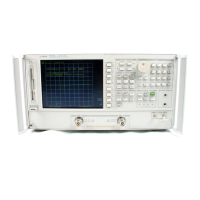Another reason for showing this example is to point out the potential problem in calibrating at
low frequencies using TRL. For example, one-quarter wavelength is
Length (cm) =
7500 x VF
fc
where:
fc = center frequency
Thus, at 50 MHz,
Length (cm) =
7500
50 (MHz)
= 150 cm or 1.5 m
Such a line standard would not only be difficult to fabricate, but its long term stability and
usability would be questionable as well.
Thus at lower frequencies and/or very broad band measurements, fabrication of a “match” or
termination may be deemed more practical. Since a termination is, in essence, an
inkitely
long transmission line, it fits the TRL model mathematically, and is sometimes referred to as a
“TRM” calibration.
The TRM calibration technique is related to TRL with the difference being that it bases the
characteristic impedance of the measurement on a matched
Zo
termination instead of a
transmission line for the third measurement standard. Like the TRL thru standard, the TRM
THRU standard can either be of zero length or non-zero length. The same rules for thru and
reflect standards used for TRL apply for TRM.
TRM has no inherent frequency coverage limitations which makes it more convenient in some
measurement situations. Additionally, because TRL requires a different physical length for the
thru and the line standards, its use becomes impractical for
fixtures
with contacts that are at a
fixed
physical distance from each other.
For information on how to modify calibration constants for
TRL*/LRM*,
and how to perform a
TRL or TRM calibration, refer to Chapter 5, “Optimizing Measurement Results.”
TRL options
i
::::i......
i
.:..:.:.:.:::.:..
:..
i
...
...
“‘.‘.”
“’
“.....“‘.““’
”
;
_/__,.,.,.,.,.,.,.............,.,.i
,_
me
$;E
~:,;;,%:~~~~~~~~::
softkey
provides
access
to
the
TRL/LRM
options
menu.
There
are
two
..z::: . .
..A
.J
.
. .
.
. .
.
.
.._..
.
. . . . . . .
. . . . . .._.......................................
;;;
+.<.;..A.;;
selections under this menu:
n
~~~~~:~
(c-&bration
&,)
: . . . . ,, ,,,. .,........
..f..
.._.
The characteristic impedance used during the calibration can be referenced to either the line
::::~~::‘j::~~~~~~~::~:::::.~~~~~:.:.:.~~~~~~:.~~~~~~~~~~~~~~~-~;~
,:,..:..:
:...
>,.
,.,~,:,~,~,~,~,~,.
B.‘:,:,.:
(,.,.,Z
(or
match)
&n&d
(~~~~~~~~
.;gQ)
or
to
the
system
(~~.;:.;~~~~~~~~~~).
me
analyzer
.._..........
._..............................-..
._...........
defaults to a calibration impedance that is equal to the line (or match) standard.
~.~~.~~..~:::......:....:.:::~~::::::::~~::~,:~~::.:.:::.::.:::.:,:::::::.::::,.,,:::::.:::::::::::.:::::::::::~::~:~
men
the
~~~~~~~~~~~~2~~
is
&e&d,
the
impedance
of
the
he
(or
mat&)
standard
is
assumed to match the system impedance exactly (the line standard is reflectionless). After
a calibration, all measurements are referenced to the impedance of the line standard. For
example, when the line standard is remeasured, the response will appear at the center of the
.,.
., . . . . . . . . .
Smith
ch&.
men
~~~~~~;~;,,~~~~~
is
selected,
l&e
values
entered
for
~~~~~
(under
Cm
?.
. . . . . . . . . . . . . . . .
..~~~...l.......i
. . . . . . . . . . . . . . . . . . . . . . .
menu)
and
~~~~~~~~.
(with
the
defie
timdad
menu)
me
ignored.
::...:,.,.:::::..
:::...
6-100 Applicationand Operation Concepts

